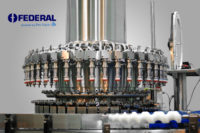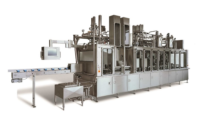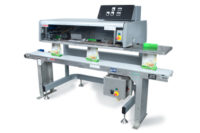Ful-filling trends in hygienic packaging

Stricter industry regulations and changing end-user demands are requiring food manufacturers to adjust their production processes and equipment. For example, growing consumer interest in new flavors for dairy products and baby food is prompting change in the industry as well as the need for a greater variety of pack styles and sizes. Additionally, dairy consumption in China and India is expected to rise significantly as these products are becoming a part of consumers’ daily diet. To keep up with the increasing demand as well as the broader variety in packaging, manufacturers are seeking new hygienic filling and packaging technologies able to handle growing volumes, various package sizes, and greater product diversity while complying with more rigorous legislation.
An additional major factor for modernizing filling and packaging equipment in operation is the growing need for food with extended shelf life (ESL). This is driven by consumer demands for food safety and product quality, burgeoning populations in harder to reach areas as well as the push to reduce product and material waste due to the global focus on sustainability. In the vast territories of India and China, for instance, it is common to transport packaged goods over long distances to remote areas. This is especially challenging when only a limited or even no cooling chain is available. Consequently, it is crucial for manufacturers to find a way to preserve their food products from the production line until the time of consumption.
As a result, hygienic filling and packaging equipment has experienced significant innovation in recent years, most notably in higher throughput and greater manufacturing flexibility. Today’s equipment enables quicker format and product changeovers to process multiple pack sizes and flavors on a single machine, as well as offers improved machine design and concepts for increased uptime and enhanced reliability. For example, Bosch’s portfolio offers a wide range of hygienic filling and packaging solutions, including thermoform machines for cups, filling machines for pre-made cups and bottles, blowing machines for PET containers, and innovative flexible pouches.
Today’s filling technologies also allow the filling and packaging of food at various hygiene levels including clean, ultra-clean and aseptic. This enables food products to have an extended shelf life and reduces waste resulting from product spoilage. The need for only minimal processing and few preservatives for conservation provides the important value-added benefit of retaining the food`s original taste.
A history grounded in shelf stability
The first processes to keep food shelf stable over longer periods of time were introduced in the 1970s. These were semi-automatic operations in which liquid hydrogen peroxide spray served as the sterilization method, and operators needed to manually control pressure gauges.
In the 1980s, programmable logic controllers (PLCs) were introduced, turning hygienic filling into an automated operation. This saved manufacturers both time and labor. Automation also enabled operators to adjust parameters to process different product recipes. During this time, Bosch Packaging Technology became a market leader in machinery for the hygienic filling of products with large-sized particulates.
In recent years, automation has significantly decreased the risk of product contamination by eliminating manual intervention. In addition, by providing thorough process documentation, automation has helped manufacturers comply with the FDA’s CFR Part 113, which mandates that low-acid food products pass microbiological challenge testing to prevent microbial growth.
Given the changes in food safety regulations over the last few years, manufacturers need to be adaptable to future legislation. This includes using packaging solutions that minimize spoilage through enhanced package integrity, for instance. Continuous fine-tuning of packaging technologies also gives food producers the flexibility to meet changing consumer demands.
Degrees of hygiene
As hygienic filling and packaging technology has advanced, so too has the understanding that different products require different levels of hygiene. The degree of hygienic processing that a particular product requires depends on a number of parameters, including pH values, desired shelf life and the known microbiological hazards.
For example, clean processing provides adequate protection and shelf stability for edible oils and hot-filled fruit juices that are largely germ-free. Other products, such as natural yogurts, cold-filled crushed tomatoes, iced tea and chilled puddings, require a more rigorous process called ultra-clean.
Aseptic filling, which is the highest hygiene level, is necessary for products such as dairy and baby food, which need to be shelf-stable outside of the cooling chain. Products low in acid, such as desserts, soups, sauces and protein-based drinks, also require aseptic filling.
The aseptic process also gives manufacturers an opportunity to extend shelf-life without losing quality or adding any preservatives. This is a key selling point for health-conscious consumers, and in many cases, can be eaten directly from the containers — the ultimate in convenience.
New flexible materials and packaging
A key innovation in packaging technology has been the evolution in packaging materials. Glass and metal were once the only options for filling viscous and liquid products with particulates. More recently, manufacturers have turned to thin-walled plastics as an alternative solution. According to the Flexible Packaging Association (FPA) , plastics are lighter in weight when compared to other formats and are also easy to carry and handle. In addition, rigid and flexible plastic packaging solutions are safe from breakage and eliminate the risk posed by broken glass, making them ideal for applications like baby food or those for on-the-go consumption. Over its lifecycle, flexible packaging generally uses less energy and fewer resources, produces lower CO2 emissions, and significantly improves product to package ratio, making it a good choice for environmentally conscious consumers.
Flexible materials also enable manufacturers to incorporate features that enhance a brand’s visual appeal by using transparent or colored materials, labels, innovative closures, spouts, shapes and straws. See-through plastic packaging also allows consumers to see products inside the package, which can influence purchasing decisions.
Getting particular with particulates
The rise in consumer preferences for liquid and viscous foods also presents challenges for the variety in filling and packaging foods with different viscosity, particulate sizes and filling patterns such as a swirl design. For example, when packaging fresh yogurt with fruit pieces, filling technologies need to be able to handle diverse particulate sizes. Machinery must be able to process particulates to desired levels and fill products into cups, bottles or pouches without damaging the particulates´ shapes and textures.
Particulates also influence taste. Therefore it is crucial that their presence is consistent from package to package to ensure consumers enjoy the same experience each time they consume the same product. Thus particulates that need to be evenly dispersed throughout a product coupled with different filling patterns pose another challenge, and manufacturing innovation has played a critical role in addressing it. Modern filling systems incorporate special pumps, fillers and nozzles that enable larger particulates to pass through without damage. In addition, further advances in machine design have enabled gentler food processing.
The next generation of filling technology
Advances in hygienic filling and packaging equipment have been the result of ongoing innovation in recent years. These developments are critical in helping food producers keep pace with industry changes and demands, whether by extending shelf life, reducing product and material waste, or advancing their lines to handle ever-changing consumer demands for various product flavors and package formats and styles. Often, working in partnership with packaging equipment suppliers can help identify the ideal solution. Bosch Packaging Technology, who brings extensive knowledge and a broad portfolio of filling and packaging solutions for liquid and viscous products, works aside many of its food industry partners to optimize their filling and packaging operations for efficiency and quality gains.
Looking for a reprint of this article?
From high-res PDFs to custom plaques, order your copy today!






